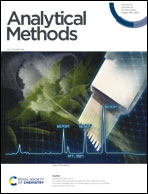An automated preloaded pipet tip SPE method for the accurate quantification of carcinogenic polycyclic aromatic hydrocarbons from tea†
Abstract
An automated polystyrene-divinyl benzene (PS-DVB) based standard preloaded-pipet tip-SPE method was developed for the prompt and precise quantification of contaminants in plant extracts using the example of polycyclic aromatic hydrocarbons (PAHs). The objective of the technique was to establish a high-throughput SPE-automated workflow with minimized personal exposure to tremendously carcinogenic PAHs during standard and sample preparation. HPLC-FLD was used for the analysis of PAHs. LOD and LOQ for the investigated PAHs were found to be 16 ppb and 59 ppb, respectively. The recoveries were between 90–102% (RSD < 8%) for the standard compounds in the pure solvent, and between 90–95% (RSD < 10%) for spiked black tea extracts. A contaminated Primulae flos extract was also subjected to the preloaded PhyTip®-SPE scheme and revealed 70.8 μg kg−1 chrysene and 60.9 μg kg−1 benzo(a)anthracene. In order to enhance method reproducibility and to increase the sample throughput, a PhyNexus® (San Jose, CA), MEA™ Robotic Purification System was used for the automation of the SPE method. The automated method with a duration of 17 minutes for 12 samples revealed high recoveries and reproducibility for the PAH standards (90–103% with RSD < 8%) and between 90–95% (RSD < 10%) for spiked black tea extracts. The presented analytical scheme provides an excellent tool for rapid and precise determination of PAHs from complex mixtures.



 Please wait while we load your content...
Please wait while we load your content...